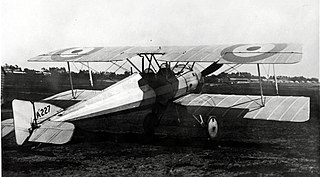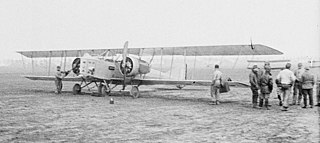
The Morane-Saulnier Type P was a French parasol wing two-seat reconnaissance aeroplane of the First World War. Morane-Saulnier built 595 for the French air force, and it was also used by the British until 1916-17.

The Morane-Borel monoplane was an early French single-engine, single-seat aircraft. It was flown in several European air races.

The Morane-Saulnier AI was a French parasol-wing fighter aircraft produced by Morane-Saulnier during World War I.

The Morane-Saulnier BB was a military observation aircraft produced in France during World War I for use by Britain's Royal Flying Corps. It was a conventional single-bay biplane design with seating for the pilot and observer in tandem, open cockpits. The original order called for 150 aircraft powered by 110-hp Le Rhône 9J rotary engines, but shortages meant that most of the 94 aircraft eventually built were delivered with 80 hp Le Rhône 9C rotaries instead. A water-cooled Hispano-Suiza 8A engine was trialled as an alternative in the Type BH, but this remained experimental only. A production licence was sold to the Spanish company Compañía Española de Construcciones Aeronáuticas (CECA), which built twelve fitted with Hispano-Suiza engines in 1916.

The Morane-Saulnier T was a French biplane reconnaissance aircraft in 1916 and produced in small numbers during World War I.

The Morane-Saulnier MS.138 was a military trainer aircraft produced in France in the late 1920s,
The Junkers T 23 was a two-seat, single-engined experimental training aircraft, built in Germany in the early 1920s. It could be configured either as a parasol winged monoplane or as a biplane to compare handling characteristics. 4 were constructed.

The Morane-Saulnier MS.180 is a single engine, single parasol wing aerobatic trainer designed in France in 1929. About seventeen were produced and used in French flying clubs, some surviving World War II and one remaining in use at a club until the 1970s. Before World War II, some were used by Spanish Republican forces to train pilots in the Spanish Civil War. Two MS.181s are still flying.

The Morane-Saulnier MS.341 was a single engine parasol wing training and touring aircraft built in France in the mid-1930s. It had two open cockpits in tandem and was sold to private owners, clubs and the Armée de l'Air.
The Gabardini biplane was an Italian single seat biplane, designed and built near the beginning of World War I. It was an advanced trainer and could be fitted with engines of output between about 40 to 80 kW.

The NVI F.K.32 was a tandem two-seat biplane training aircraft designed and built in the Netherlands in the mid-1920s. It did not go into service.
The Ponnier M.1 was an early French World War I fighter aircraft Most of those produced were operated by the Aviation Militaire Belge. They were deemed unusable by the Belgian ace Willy Coppens and rapidly retired.
The Caudron C.220 was a two-seat French biplane trainer. Only two were built, using different engines.

The Caudron C.43 was the first French five-engined aircraft, a biplane intended for passenger transport or military use and multi-engined for safety. A development of the three-engined Caudron C.39, it had one tractor configuration engine in the nose and two push-pull pairs between the wings. It was capable of carrying eight passengers but was not developed.
The Caudron C.37 was a French three-engined biplane passenger transport, built in 1920. It could carry six passengers.

The Morane-Saulnier MS.350 was a French aerobatic trainer flown in 1936. Only one was built but it had a long career, flying post-war until the 1960s.
The Morane-Saulnier MS.300 and MS.301 were French parasol wing introductory trainer aircraft, first flown in 1930. They differed only in engine type. Neither reached production but were developed into two similar trainers, the MS.230 and MS.315, which were made in large numbers.
The Morane-Saulnier MS.152 was a French multi-purpose aircraft built in 1928. It did not go into production.

The Morane-Saulnier MS.221 was a French fighter aircraft, built in 1928 to compete for a government contract in the "Jockey" programme. Two were built, one of which was progressively modified to increase its speed, but in 1930 the light fighter concept was abandoned.
The SPAD S.XV was a single-seat fighter designed and built in France and offered to fulfil a 1918 C1 specification.













